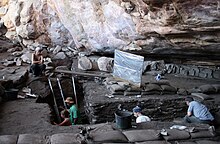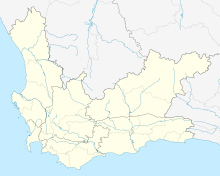Diepkloof Rock Shelter
| Diepkloof Rock Shelter | |
|---|---|
 General view of Diepkloof Rock Shelter | |
| Location | Verlorenvlei, Western Cape |
| Coordinates | 32°23′12″S 18°27′10″E / 32.38667°S 18.45278°E |
| Geology | Quartzitic Sandstone |


Diepkloof Rock Shelter is a rock shelter in Western Cape, South Africa in which has been found some of the earliest evidence of the human use of symbols, in the form of patterns engraved upon ostrich eggshell water containers. These date around 60,000 years ago.[1][2]
The symbolic patterns consist of lines crossed at right angles or oblique angles by hatching. It has been suggested that "by the repetition of this motif, early humans were trying to communicate something. Perhaps they were trying to express the identity of the individual or the group."[3]
Site description
The cave is about 17 kilometres (11 mi) from the shoreline of the Atlantic Ocean in a semi-arid area, near
It was first excavated in 1973 by John Parkington and Cedric Poggenpoel.[4] Since 1999 it has been researched in a collaboration between the Department of Archaeology at the University of Cape Town and the Institute of Prehistory and Quaternary Geology at the University of Bordeaux.[2]
At Diepkloof Rock Shelter (DRS), from 70 to 74 ka bifaces and bifacial points are present while less complex forms such as backed artifacts occur from 70 ka through 60 ka and are subsequently replaced with unifacial points. Quartz and quartzite predominate the earliest unit with few occurrences of silcrete. During 70-74 ka unit, silcrete has replaced quartz while quartzite is still fairly dominant. From 65 to 70 ka quartz becomes dominant again with quartzite also being present.[5]
Engraved ostrich eggshell containers
Some 270 fragments of ostrich eggshell containers have been found covered with engraved geometric patterns. The fragments have a maximum size of 20–30 mm, though a number have been fitted into larger 80 × 40 mm fragments. It is estimated that fragments from 25 containers have been found. Eggshell fragments have been found throughout the period of occupation of the cave but those with engraving are found only in several layers within the Howiesons Poort period. These occur across 18 stratigraphic units, particularly those with the stratigraphic names Frank and Darryl. This suggests the tradition of engraving lasted for several thousand years.[1]
The engraving consists of abstract linear repetitive patterns, including a hatched band motif. One fragment has two parallel lines that might have been circular around the container.
It has been suggested that they form "a system of symbolic representation in which collective identities and individual expressions are clearly communicated, suggesting social, cultural, and cognitive underpinnings that overlap with those of modern people."[1] Moreover, they show "the development of a graphic tradition and the complex use of symbols to mediate social interactions. The large number of marked pieces shows that there were rules for composing designs but having room within the rules to allow for individual and/or group preferences."[1]
Earlier finds exist of symbolism, such as the 75,000-year-old engraved ochre chunks found in the
The engravings are found on ostrich eggshells that were used as water containers. Ostrich eggshells have an average volume of 1 litre. They may have had drinking spouts, holes to enable them to be strung as a canteen for easier carrying, and seem to have been part of "daily hunter-gatherer life".[1] They involved skill to make, with one of the researchers involved noting "Ostrich egg shells are quite hard. Doing such engravings is not so easy."[3]
Local flora
The preservation of organic matter such as wood, grass, seeds and fruits at the site has been described as "exceptional".
Animal remains
Animal remains include those of mammals, tortoises and
Tortoise bones are mostly those of the
Provincial heritage site

Diepkloof Rock Shelter was declared a provincial heritage site by Heritage Western Cape on 23 September 2014 in terms of Section 27 of the National Heritage Resources Act.[6] This gives the site Grade II status and provides it with protection under South African heritage law.
In 2015, the South African government submitted a proposal to add the caves to the list of World Heritage Sites and it has been placed on the UNESCO list of tentative sites as a potential future 'serial nomination' together with Blombos Cave, Pinnacle Point, Klasies River Caves, Sibudu Cave and Border Cave.[7]
References
- ^ PMID 20194764.
- ^ .
- ^ a b c Amos, J. (2010). Etched ostrich eggs illustrate human sophistication. BBC News
- ISBN 978-0-86054-425-8
- ^ Mackay, Alex; Marwick, Ben (2011). "Costs and benefits in technological decision making under variable conditions: examples from the late Pleistocene in southern Africa". Keeping your Edge: Recent Approaches to the Organisation of Stone Artefact Technology.
- ^ Provincial Notice 253/2014, Province of the Western Cape Provincial Gazette Extraordinary, No. 7310, Cape Town: 23 September 2014
- ^ "The Emergence of Modern Humans: The Pleistocene occupation sites of South Africa". UNESCO. Retrieved 3 April 2015.

